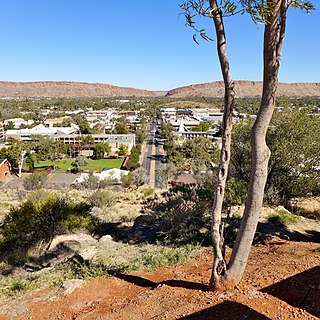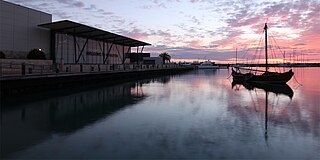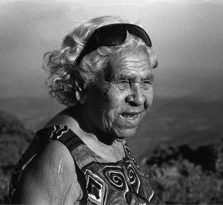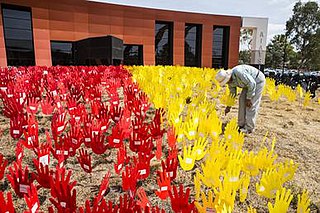
The Northern Territory is an Australian territory in the central and central northern regions of Australia. The Northern Territory shares its borders with Western Australia to the west, South Australia to the south, and Queensland to the east. To the north, the territory looks out to the Timor Sea, the Arafura Sea and the Gulf of Carpentaria, including Western New Guinea and other islands of the Indonesian archipelago.

Alice Springs, is the second-largest town in the Northern Territory, Australia. The name Alice Springs was given by surveyor William Whitfield Mills after Alice, Lady Todd, wife of the telegraph pioneer Sir Charles Todd. Known colloquially as 'The Alice' or simply 'Alice', the town is situated roughly in Australia's geographic centre. It is nearly equidistant from Adelaide and Darwin.

Geraldton is a coastal city in the Mid West region of Western Australia, 424 kilometres (263 mi) north of the state capital, Perth.

Footscray is an inner-city suburb in Melbourne, Victoria, Australia, 5 km (3.1 mi) west of Melbourne's Central Business District, located within the City of Maribyrnong local government area and its council seat. Footscray recorded a population of 17,131 at the 2021 census.

Toodyay, known as Newcastle between 1860 and 1910, is a town on the Avon River in the Wheatbelt region of Western Australia, 85 kilometres (53 mi) north-east of Perth. The first European settlement occurred in the area in 1836. After flooding in the 1850s, the townsite was moved to its current location in the 1860s. It is connected by railway and road to Perth. During the 1860s, it was home to bushranger Moondyne Joe.

Queenie McKenzie (Nakarra) (formerly Oakes, or Mingmarriya) (c. 1915 – 16 November 1998) was an Aboriginal Australian artist. She was born on Old Texas Station, on the western bank of the Ord River in the East Kimberley.

Halls Creek is a town situated in the east Kimberley region of Western Australia. It is located between the towns of Fitzroy Crossing and Turkey Creek (Warmun) on the Great Northern Highway. It is the only sizable town for 600 km on the Highway.

The Australian Institute of Aboriginal and Torres Strait Islander Studies (AIATSIS), established as the Australian Institute of Aboriginal Studies (AIAS) in 1964, is an independent Australian Government statutory authority. It is a collecting, publishing and research institute and is considered to be Australia's premier resource for information about the cultures and societies of Aboriginal and Torres Strait Islander peoples. The institute is a leader in ethical research and the handling of culturally sensitive material and holds in its collections many unique and irreplaceable items of cultural, historical and spiritual significance. The collection at AIATSIS has been built through over 50 years of research and engagement with Aboriginal and Torres Strait Islander communities and is now a source of language and culture revitalisation, native title research and family and community history. AIATSIS is located on Acton Peninsula in Canberra, Australian Capital Territory.
Oombulgurri, also written as Umbulgara, was an Aboriginal community in the eastern Kimberley, 45 kilometres (28 mi) by air and about 210 kilometres (130 mi) by road northwest of Wyndham. It was first established as the Forrest River Mission in 1913. It had a population of 107 as of the 2006 census. It was inhabited by the Yeidji people who now self-identify as Balanggarra. In 2011, the government of Western Australia encouraged residents of Oombulgurri to move elsewhere, after it deemed the community unsustainable. The last residents from Oombulgurri were relocated to Wyndham just before Christmas 2011. There is still a locality with this name that includes the surrounding area, which had a population of 27 at the 2021 census.

Mullewa is a town in the Mid West region of Western Australia, 450 kilometres (280 mi) north of Perth and 98 kilometres (61 mi) east-northeast of Geraldton. Mullewa is well known for its abundance of wildflowers in the spring and is one of the few places in Western Australia the wreath flower grows in. The surrounding areas produce wheat and other cereal crops. The town is a receival site for Cooperative Bulk Handling.
Indigenous Australians are people with familial heritage from, and membership in, the ethnic groups that lived in areas within the Australian continent before British colonisation. They consist of two distinct groups: the Aboriginal peoples of the Australian mainland and Tasmania, and the Torres Strait Islander peoples from the seas between Queensland and Papua New Guinea. The term Aboriginal and Torres Strait Islander peoples or the person's specific cultural group, is often preferred, though the terms First Nations of Australia, First Peoples of Australia and First Australians are also increasingly common; 812,728 people self-identified as being of Aboriginal and/or Torres Strait Islander origin in the 2021 Australian Census, representing 3.2% of the total population of Australia. Of these Indigenous Australians, 91.4% identified as Aboriginal; 4.2% identified as Torres Strait Islander; while 4.4% identified with both groups. Since 1995, the Australian Aboriginal flag and the Torres Strait Islander flag have been official flags of Australia.

An Indigenous Protected Area (IPA) is a class of protected area used in Australia; each is formed by voluntary agreement with Indigenous Australians, and declared by Aboriginal Australians and Torres Strait Islander representative organisations. Each is formally recognised by the Australian Government as being part of its National Reserve System. The areas may comprise land and sea, and are managed by Indigenous groups for the conservation of biodiversity. Managing IPAs also helps to protect the cultural values of their country for future generations, and has benefits for Indigenous health, education, economic and social cohesion.

Aboriginal communities in Western Australia are communities for Aboriginal Australians within their ancestral country; the communities comprise families with continuous links to country that extend before the European settlement of Australia.
Syrian Australians are Australians of Syrian descent or Syria-born people who reside in the Commonwealth of Australia. Australian Syrians make up 0.4 percent of the Australian population, with a gender split of 51.3 percent female, 49.7 percent male. The 2016 Australian census revealed 68.8 percent of Syrian Australian homes have Arabic as the language spoken at home, however of the homes where English is not the first spoken language, 37.7 percent are able to speak English fluently. The majority of Syrian Australians arrived prior to 2007, with a small group immigrating between 2007–2011 then a larger group entering between 2012–2016.
Gerry Georgatos is a university researcher and social justice and human rights campaigner based in Western Australia. He has campaigned for prison reform, as well as championing the rights of the impoverished and marginalised and the homeless.
Matagarup Refugee Camp is a political protest against the Western Australian Government's threat to close many Aboriginal remote communities and safe space for Noongar homeless people. Matagarup is the Noongar name for Heirisson Island which is situated in the centre of Perth. On 1 March 2015 more than 100 Aboriginal protesters and homeless people established a "refugee protest" camp at Heirisson Island in response to the threat by State Government of forced closures of small remote communities. The City of Perth Shire has refused the right of the protesters to camp, protest and to shelter the homeless. The City of Perth raided the island camp nine times between March and August 2015, usually escorted by a large police presence, and confiscated the tents and belongings of the campers and the homeless. During some of the raids police have been accused of "an excessive use of force". Some of the raids have led to police arresting campers, handing out move-on notices and in court appearances but the campers and the homeless continue to return. On each occasion the camp has re-established itself, led by Nyungah Elder, Bella Bropho, who has camped on the island since 1 March 2015.
The Ngaatjatjarra are an Indigenous Australian people of Western Australia, with communities located in the north eastern part of the Goldfields-Esperance region.

Bellbrook is a locality in the Kempsey Shire of New South Wales, Australia along the Macleay River. The mountain village is classified by the National Trust as a heritage village and is part of the Macleay Valley Coast.
Daisy Bindi (1904—1962), also known as Mumaring, was an Aboriginal Australian Indigenous rights activist and a leader in the landmark 1946 Pilbara strike in Western Australia.
Bindi Mwerre Anthurre Artists, or Mwerre Anthurre, is an Aboriginal Art Centre based in Alice Springs. It was established in 2000 to encourage, nurture and support Aboriginal artists with disabilities and the organisation focuses on empowerment through art.